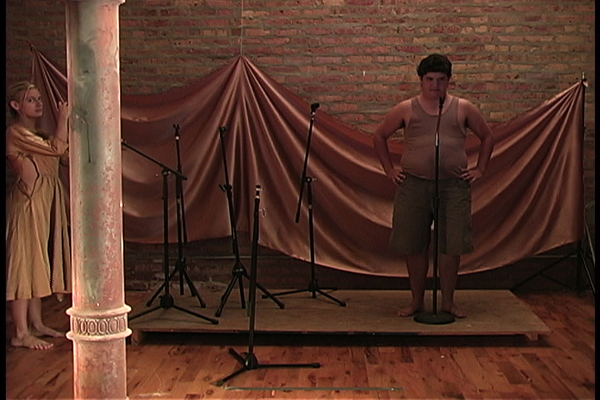 Sweet Nightingale
Sweet NightingaleBlurb:
Recent film and video works by international artists illustrate how the new social forms and ways of understanding “community” explored in The Power Plant exhibition ‘If we can’t get it together’ have evolved radical forms of communication and representation. These works feature bodies struggling to make a social “movement” together, tenuously joining forces into unexpected alliances, only to fall apart again.
Malaysian artist Liew Seng Tat’s Matahari (The Sun), 2007, empathetically observes a sad little boy as he struggles against the cheery vibe of a pageant that he’s dressed for. American Emily Roysdon’s Social Movement, 2005, explores “the interplay of bodies and collectivity of movement and remembering” through a group of people as they tentatively erect a stage. The huddle of people in German Ulla von Brandenburg’s Around, 2005, refuse us entry to their circle, turning their backs to us. Russian Victor Alimpiev’s Sweet Nightingale, 2005, sets a crowd’s mysterious shared gestures to the strains of Mahler, while Finnish artist Jani Ruscica’s Batbox/Beatbox, 2007, juxtaposes an examination of bat echolocation with footage New York beatbox artists. Finally, Waltz on Thin Air, 2008, by Eric Beveraggi & Charles Bédué, introduces individuals who are just beyond normal: drop-outs from any kind of cohesive or united community, they are linked only by their mutual deviance and difference.
 Sweet Nightingale
Sweet Nightingale
 Social Movement
Social Movement
 Matahari (The Sun)
Matahari (The Sun)
 Around
Around
 Batbox/Beatbox
Batbox/Beatbox
 Waltz on Thin Air
Waltz on Thin Air
Opening Remarks:
Welcome everyone to the screening, Together, Alone, a selection of recent international videos curated by myself and by Nina Möntmann, guest-curator of The Power Plant’s current exhibition ‘If We Can’t Get It Together,’ which runs until February 22 along with the exhibitions 'Goldin+Senneby: Headless' and 'Emily Vey Duke and Cooper Battersby: Beauty Plus Pity.'
These works explore how new social forms, collectivities and ways of understanding "community" offer a challenge to how we relate to one another, communicate and represent ourselves and others.
Many of these works, such as German artist Ulla von Brandenburg’s Around (from 2005) and Malaysian artist Liew Seng Tat’s Matahari (The Sun) (from 2007) highlight tensions between individual and communal bodies through choreography, focusing on the struggle between the one and the many. Alliances are tenuous and fleeting, always wracked by exclusions whether self-imposed or out of one’s control. American artist Emily Roysdon describes her silent video Social Movement (from 2005) as attempting, “to simultaneously create and perform the stage, to frame performance and memory through slow repetitious gestures. Constantly preparing the document of our presence, and the monument of our persistence.”
In the first video of the program, Russian artist Victor Alimpiev's Sweet Nightingale (from 2005), we see a man’s private gestures mimicked by a large group, their repetition invests his small actions with a shared significance – but what exactly does this transmission mean, if anything? Toronto video artist Rodney Werden, who was most active in the 70s and 80s, making both complex experimental narratives and provocative non-fiction works about sexuality and power, also stages a game of follow the leader in his 1973 tape, Say, but here the power dynamic between director and subject becomes a satire of authoritarianism.
In Say, power is given form through verbal language, specifically through giving orders, but in Finnish artist Jani Ruscica’s diptych Batbox/Beatbox (from 2007), the spoken word and sound in general are more ambiguous and malleable. The artist describes the work as paralleling two different environments: “nature depicted through bats' nightly echolocation and the urban metropolis navigated by hip-hop artists. Focusing on two different ways to use sound and movement as tools to navigate and identify one's environment, in Batbox, sound and movement is portrayed as a biological phenomenon, in Beatbox, as a cultural one.”
Finally, the half-hour Waltz on Thin Air (2008) by Shanghai-based French artists Eric Beveraggi & Charles Bédué, introduces individuals who are just beyond normal: drop-outs from any kind of cohesive or united community, they are linked only by their mutual oddity and difference. This video also returns us to the question of ethics and how one represents the other, as the filmmakers seem to have only included the scenes of their subjects that portray them in a deviant light, as if the media itself might be the greatest barrier to social cohesion, but then again what value or fun would there be in achieving the superficial harmony of uniformity?